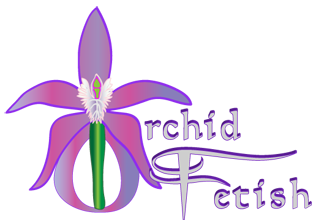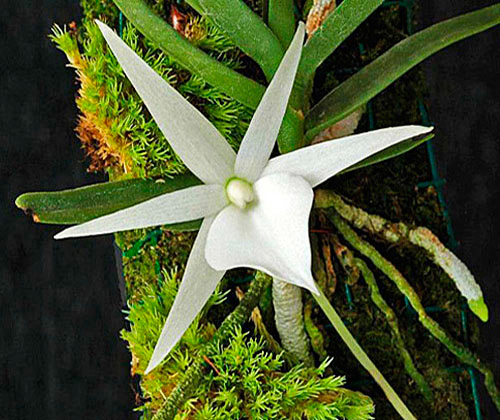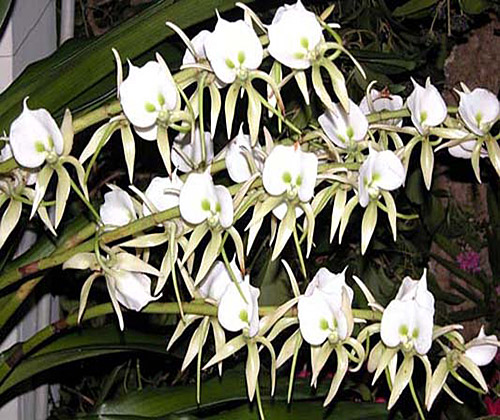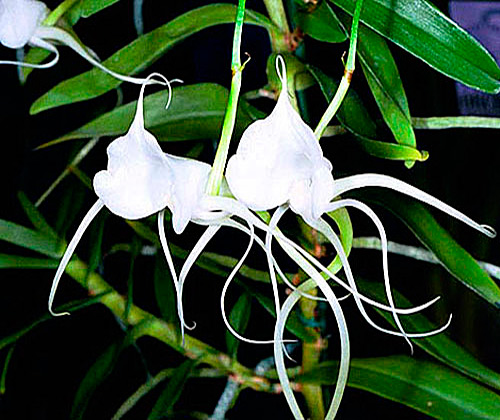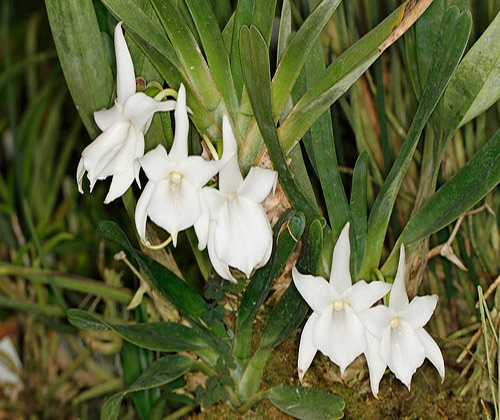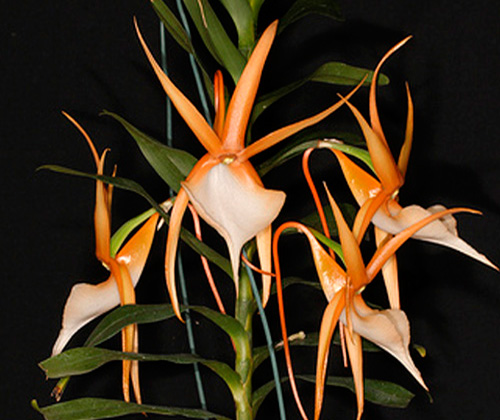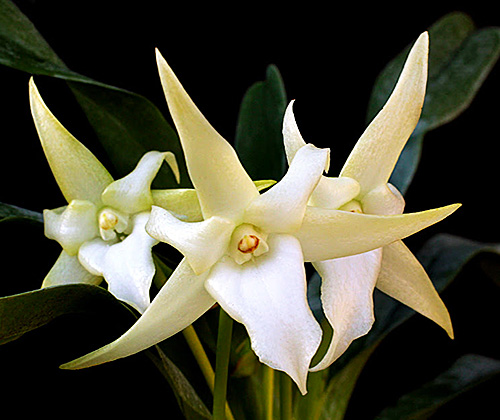Angraecum Species Orchid
Angraecum species currently number 221 accepted. New species are still being discovered in the rain forests of Madagascar. These exquisite epiphytes, ghostly stellar forms of Angraecum orchids release a sweet fragrance onto the night air, attracting moths as their pollinators. There is no landing platform as moths usually prefer to hover in front of a flower. Abundant sweet nectar is hidden in deep narrow tubes around 30 cm long - only accessible to those with very long tongues such as the famous Madagascan 'Sphinx Moth' (Xanthopan morgani praedicta). In the case of Angraecum sesquipedale, a species from Madagascar, on observing the 30cm spur in the lip, Charles Darwin theorised that, since the nectar was at the bottom of the spur, a pollinator must exist with a tongue at least that long. Otherwise the orchid could never be pollinated. At the time, he was not believed. However, long after Darwin's death, the predicted pollinator was discovered, a hawk moth now named Xanthopan morganii praedicta (praedicta meaning predicted). It had an appropriately long proboscis. The specific name 'sesquipedale' means 'one foot and a half', referring to the length of the spur. This is a perfect example of mutual dependence of an orchid and a specific pollinator.
Growing Angraecum
They are quite varied vegetatively and florally and are adapted to dry tropical woodland habitat and have quite fleshy leaves as a consequence. Most are epiphytes, but a few are lithophytes. Tropical Africa and Madagascar contain the majority of the genus with outlying species in southeast Asia. But these orchids can also be found on the Comoros, the Seychelles, and the Mascarenes. They occur between sea level and 2,000 m in humid regions. The long-lasting flowers are racemose and grow from the leaf axils. They are mostly white, but a few are yellow, green or ochre. They all have a long spur at the back of the labellum (lip).
Light
Lighting needs vary and most like intermediate lighting,but some do well with high lighting similar to Cattleya or Vanda. Because Angraecum are epiphytic orchids and grow high up in trees where they receive plenty of light, they should be given the maximum light available which should be diffused to prevent scorching of the leaves which are the food store for the plant.
Temperature
Warm Growing-15 - 28 C (60 - 82F). The species come from enough different habitats and altitudes that there is some variation in temperature requirements, but most do best at intermediate temperatures, in the lower 70's Fahrenheit during the day (21-25C), and cooling by 10-15°F (6-8C) at night.
Water & Humidity
Mature plants must dry out between waterings. Seedlings need more constant moisture. Water these orchids just as their potting mix dries out, or as it approaches dryness when the plant is in bloom. They like to dry out relatively quickly, so use a well-drained mix that doesn't retain too much moisture; medium or coarse fir bark works well. Some people use a more moisture-retaining medium such as sphagnum moss, but in a clay pot.
Feeding
The plants are moderate feeders and a general purpose plant food can be applied from April to September at ¼ the pack recommendation, feed these plants every third watering. Flush the pot or basket out once a month with clean water to remove any unused plant food and salts which can build up in the compost and harm the roots. During late August and September you should water with a higher potash feed again at ¼ strength and every third watering) which will encourage the new leaves to harden in readiness for the darker winter months. Feeding should cease by late October and no more should be given until the following late winter (Feb/Mar) at which time normal feeding can resume.
Potting
Angraecum are naturally epiphytic and can be grown either in a pot, basket or mounted on to bark. If planted in pots then large open grade compost or bark with the addition of 1/4 sphagnum peat should be used to allow swift drainage whilst holding moisture, in this case you should re-pot the plants every year or every other year depending on it's size, this should be undertaken in spring as growth re starts. If grown in baskets or on bark then re planting can be left for two to three years or until they become unmanageable before being re planted. Medium or coarse fir bark works well. Some people use a more moisture-retaining medium such as sphagnum moss, but in a clay pot.
